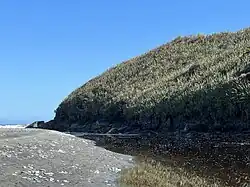Gillespies Point / Kōhaihai
Gillespies Point / Kōhaihai is a small headland on the west coast of New Zealand's South Island. The point marks the north-eastern end of Gillespies Beach and the western end of Waikowhai Bluff, as well as the mouth of Waikowhai Stream. The point is deemed to have high conservation value despite not being covered by Westland Tai Poutini National Park or Waiau Glacier Coast Marine Reserve, and is a relatively untouched haul-out site of New Zealand fur seals.
Gillespies Point / Kōhaihai
| |
|---|---|
 Gillespies Point / Kōhaihai at the mouth of the Waikowhai Stream | |
 Gillespies Point / Kōhaihai Location of Gillespies Point / Kōhaihai | |
| Coordinates: 43.397°S 169.841°E | |
| Location | Westland District, New Zealand |
| Offshore water bodies | Tasman Sea, Waikowhai Creek |
| Formed by | Glaciation, coastal erosion |
| Geology | Glacial moraine, primarily greywacke |
| Etymology | Unclear Māori etymology. Named Gillespie after James Edwin Gillespie |
| Native name | Kōhaihai (Māori) |
| Defining authority | New Zealand Geographic Board |
| Elevation | 21 metres (69 ft) |
Geography
Gillespies Point / Kōhaihai is located at the north-eastern limit of Gillespies Beach, which runs for roughly 5 kilometres (3.1 mi) between Kōhaihai and Otorokua Point to the southwest, approximately 16 kilometres (9.9 mi) from the town of Fox Glacier. The point is the westernmost portion of moraine deposits which extend from Cook Saddle, some 18 kilometres (11 mi) inland, deposited by glaciers in the region during earlier ice ages.[1] Upon reaching the shore, erosion of this moraine has formed a line of coastal cliffs which stretches as far as the Waikukupa River, 15 kilometres (9.3 mi) to the northeast. In some areas, these cliffs have become further inland due to rivers in the area depositing large amounts of gravel along the region's shore.[1]
Immediately to the south of Gillespies Point / Kōhaihai is the mouth of Waikowhai Stream, which separates the point from the beach to the south. This stream, along with its many tributaries, drains a large area of wetlands behind Gillespies Beach, which are ecologically significant and form part of Westland Tai Poutini National Park.[2]
History and name

The headland was first known to local Māori as Kōhaihai (recorded in some early sources as Kaohaihi), although the origins of this name are not known.[3][4] As Pākehā settlement of the area increased, the headland was renamed Gillespies Point after James Edwin Gillespie, who discovered gold on the beach in 1866 during the West Coast Gold Rush.[5] At the time, the track to the region closely followed the coast due to the ease of navigating beaches compared to the dense forest of the interior, with bluffs and headlands such as Gillespies Point acting as significant obstacles and making the journey tide-dependent.[6] To enable consistent access to Gillespies Beach and further south, as well as make the journey safer, miners in the area cut a tunnel through Gillespies Point, which has since been closed due to the impact of erosion at the seaward end.[4]
In 1998, Gillespies Point / Kōhaihai became one of nearly 100 places to be given an official dual place name through the Ngāi Tahu Claims Settlement Act 1998, a landmark Treaty of Waitangi settlement between Ngāi Tahu and the New Zealand government, recognising the shared significance of the point to Pākehā and Māori of the region.[3]
Ecology
Despite not being included within the boundaries of Westland Tai Poutini National Park, Gillespies Point / Kōhaihai has been recognised as an area of high conservation value, and may be suitable as an addition to the National Park.[7] The point is a small haul-out site of New Zealand fur seals, with just 35 seals counted during one survey.[8] Although relatively small in size, this haul-out is significant due to its relative lack of human disturbance.[7]
The forests of Gillespies Point / Kōhaihai are similar to those found across the moraine which it is part of, and consist mostly of young hardwood trees with a few more mature trees, such as kahikatea, rimu, or miro.[9][10] Erosion of the coastline poses a threat to this forest, as does the salt spray from the nearby ocean.[9]
References
- Wellman, H. W.; Willett, R. W. (1942). "The Geology of the West Coast from Abut Head to Milford Sound. Part 2. Glaciation". Transactions and Proceedings of the Royal Society of New Zealand. 72: 199–219. Retrieved 23 September 2023.
- "Westland Tai Poutini National Park Management Plan" (PDF). doc.govt.nz. Department of Conservation Te Papa Atawhai. Retrieved 23 September 2023.
- Alexander, Vonnie (2010). Gillespies Beach Beginnings. Christchurch: Alexander Publications. ISBN 978-0-473-17756-0.
- "Place name detail: Gillespies Beach". New Zealand Gazetteer. New Zealand Geographic Board. Retrieved 23 September 2023.
- "A tunnel through Gillespie Point,north of Gillespies Beach. 1954". West Coast New Zealand History. Retrieved 23 September 2023.
- "Reclassificartion - Statutory Management Planning" (PDF). doc.govt.nz. Department of Conservation Te Papa Atawhai. Retrieved 23 September 2023.
- Wilson, G. J. "Distribution and Abundance of the New Zealand Fur Seal, Arctocephalus forsteri" (PDF). niwa.govt.nz. National Institute of Water and Atmospheric Research. Retrieved 23 September 2023.
- Wardle, P. (1974). "The Kahikatea (Dacrycarpus dacrydioides) Forest of South Westland" (PDF). Proceedings of the New Zealand Ecological Society. 21: 62–71. Retrieved 22 September 2023.
- Pocknall, D.T. (March 1981). "Pollen morphology of the New Zealand species of Dacrydium Selander, Podocarpus L'Heritier, and Dacrycarpus Endlicher (Podocarpaceae)". New Zealand Journal of Botany. 19 (1): 67–95. doi:10.1080/0028825X.1981.10425191.